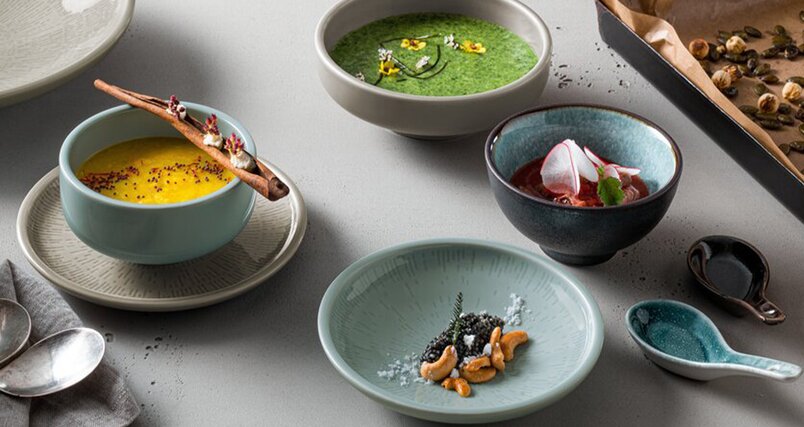Food bowls are more popular than ever – no wonder, because the colorful bowls are not only visually eye-catching, but thanks to endless preparation options, especially versatile. In gastronomy, food bowls offer the opportunity to provide guests with more variety on the menu and healthy alternatives to traditional dishes.
What are food bowls?
Food bowls are dishes that are arranged and served in a visually appealing manner in a larger bowl or dish rather than on a plate. The base of food bowls are vegetables, satiating carbohydrates and proteins, garnished with healthy toppings, dressings and fruits. They can be prepared savory or sweet. Depending on the season, the bowls can also be enriched with fresh seasonal ingredients.
Where did food bowls originate?
The origin of the food bowl trend is considered to be the clean-eating movement. The diet is based on the idea that avoiding industrial foods – and instead using fresh, wholesome and unprocessed ingredients – has positive effects on body and health. Thus, clean-eating predominantly involves the consumption of fresh fruits and vegetables, grains, nuts and seeds. Industrially processed products, foods with flavor enhancers, colorings, preservatives and sugar do not go on the plate (or in the bowl).
What is so special about food bowls?
Food bowls embrace the idea of the clean-eating movement and offer a rich and balanced meal thanks to their valuable nutrients and few calories. The exceptional look of the food bowls not only appeals to health-conscious guests. Unlike salads, where all the ingredients are mixed through, bowls involve cutting the components into bite-sized pieces and arranging them decoratively in the bowl.
The result is a light, colorful, yet high-quality source of protein and energy that can be served in a restaurant for lunch or dinner. Food bowls have also established themselves worldwide as a healthy snack for in-between meals or as a convenient meal to go.
What benefits do food bowls present to gastronomy?
Adding food bowls to the restaurant's menu offers several advantages for restaurateurs. The "bowl meal" meets the desire of guests for a more health-conscious diet. Furthermore, bowls are compatible with many individual eating styles, such as vegan, vegetarian, gluten-free or raw food diets. Whether basic ingredients, dressing or extras – food bowls have high individualization potential and can be prepared quickly and easily.
Due to the high trend factor, a higher margin can be earned with bowls in gastronomy than with a classic salad, for example. Offering individual creations can give your restaurant a unique selling point. Additionally, thanks to the appealing look, you will get free advertising on social media, as satisfied guests will be happy to share pictures of their food bowls and link to your establishment.
Ideas for food bowls in the fall
If you want to delight your guests with varied food bowls in the fall, you should focus on fresh, seasonal ingredients and creative variations. Each bowl should have at least four components that harmonize well with each other, both in terms of taste and appearance. Likewise, you can offer the option to customize their own bowl.
- Foundation: rice, potatoes, sweet potatoes, quinoa, bulgur, whole wheat pasta, glass noodles, couscous, buckwheat, lamb's lettuce, chard, arugula, spinach leaves, endive, radicchio, amaranth
- Vegetables: squash, mushrooms, beet, parsnips, celery, carrots, peppers, snow peas, corn, beans, peas, chickpeas, savoy cabbage, zucchini, kohlrabi, eggplant, broccoli, cauliflower, red cabbage, white cabbage, Brussels sprouts, kale, avocado, radishes, corn, radish
- Fruit: apples, pears, quinces, figs, plums, pomegranate
- Extras: tofu, soy, seitan, meat, fish, falafel
- Toppings: hazelnuts, walnuts, pumpkin seeds, chia seeds, feta, sprouts, dried fruits, hemp seeds, roasted onions, herbs
- Dressings & dips: tahini, sesame, peanut, avocado, guacamole, cashew, honey mustard, hummus, chilli, barbecue, yoghurt, soy, balsamic vinegar
















